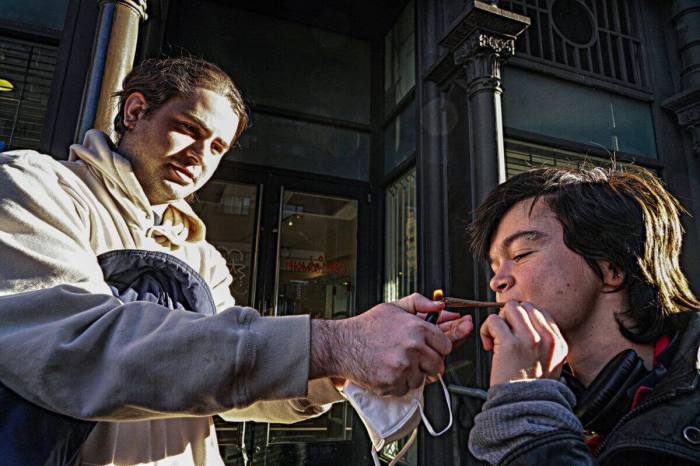BY SCOTT STIFFLER & WINNIE McCROY | After all the well-attended community forums, petition campaigns, emails to electeds and raucous Community Board 4 (CB4) public comment sessions, it all came down to this: The May 2 full board meeting was the last opportunity for the public to weigh in on Jamestown Properties’ desire to vertically expand Chelsea Market (before CB4 votes on it). If approved, the project would add as much as 330,000 square feet of space to the iconic building.
The exact square footage is still a matter of debate — sure to change if Jamestown withdraws its longstanding plan to add a 90,000 square foot hotel to the Ninth Avenue side of Chelsea Market (the initial plan also called for 240,000 square feet of office space on the market’s Tenth Avenue side).
During a recent phone interview with Chelsea Now, CB4 District Manager Bob Benfatto said, “In our last conversation with Jamestown, we were told we’d get something in writing promising no hotel and no drinking or eating establishments on the roof.” The assurance, which Benfatto notes took place at the May 2 CB4 meeting, was just one of several notable developments to occur that night.
About 150 members of the public attended the meeting — which began with a presentation by Land Use Lawyer Melanie Meyers, David Burns (of Studio Architecture) and Michael Phillips (Chief Operating Officer, Jamestown).
Once again making the argument for expansion as necessary for the area’s economic growth, Phillips stated, “There is a demand from our media and high-tech clients for more office space. The additional square footage is about accommodating them from within. There are 1,000 permanent jobs to be created by this.” He then recalled how since acquiring the property, “We have grown the business, and been a good steward.”
Addressing concerns that the influx of more media and technology tenants would negatively impact the ground floor (via more upscale services at the cost of resident- and tourist-friendly businesses), Phillips maintained, “The food businesses are an open platform to attract people from all sectors of the neighborhood. We spent the last 14 years focusing on the ground floor food culture. The market started as a warehouse for florists, then moved into food. The ground floor businesses attract offices, and offices in turn support those businesses. We are fostering business and growth in Chelsea.”
As for potential changes in the project’s square footage should the notion of adding a hotel be abandoned, Meyers stated, “At the last meeting, we heard concerns about having any kind of hotel, about the height of the site, and about the treatment of the older building. The applicant is comfortable with the changes we’ve made. The ULURP [Uniform Land Use Review Procedure] stated 11 stories, but potentially this will now be seven stories. We will reduce it, because we look to line it up with the existing base plates of the building. We want the building to remain active and vibrant, so consider our commitment that a portion of the ground floor remain food-based business.”
During the public comment session, 24 people signed up to speak — with 17 opposing, and 7 supporting the project.
Referencing “development, most of which we have not benefited from,” the Greenwich Village Society for Historic Preservation’s Andrew Berman observed, “We can’t do anything about Hudson Yards. But this can be stopped.” Michael Barrett, however, countered that, “Chelsea Market is the nucleus of the neighborhood,” and urged CB4 to “work with them [Jamestown] to move it forward.”
Support for Jamestown also came from Joshua David, a co-founder of Friends of the High Line. “I hope you will work together with them,” he implored CB4. “We need capital funds to keep High Line public amenities and critical infrastructure.” Ian McGregor, proprietor of The Lobster Place (and a stakeholder in Jamestown) also spoke in favor of expansion — recalling, “Our business couldn’t have grown without Chelsea Market growing this fertile ground. In words and deeds, they [Jamestown] have shown me that Lobster Place will remain part of their future.”
Frank Lowe, a 36-year resident of Chelsea, was not convinced. “Don’t be seduced by the promise of 1,000 high-tech jobs that they [Jamestown] don’t control or create,” he warned, adding that the $17 million donation promised to the High Line “is not worth damage to light and air” on the elevated park. Justin Hoy, co-president of Save Chelsea, said, “I can’t imagine why anyone would consider giving our historic building to a foreign investment company. Try going to Cologne where Jamestown is headquartered and telling them you are building a giant glass tower on top of their historic buildings and see what happens. Elected officials have come against it. If CB4 approves it, we should be embarrassed. This bargaining is preposterous.”
During a period of questions from CB4 members, Burt Lazarin asked, “You say you are considering this, and working on that; we have to vote. When will you release concrete drawings?” — to which Meyers noted that Jamestown is “shooting for the May 31 committee meeting.”
That meeting, of the Chelsea Preservation and Planning Committee (CP&P), will conclude with a recommendation to the full board — in anticipation of a vote to take place at the June 6 meeting of CB4.
Previewing the CP&P meeting (which begins at 6pm and takes place at Fulton Auditorium, 119 Ninth Avenue, between 17th & 18th Streets), Benfatto noted, “There will be deliberation and a vote by the committee.” The public, which will not be able to comment or ask questions (as they have at past meetings), “will see the entire committee talk between themselves on the issues, and there might be some handouts and another visual aid or two…especially since we know now there’s going to be a 28-story story hotel building directly across the street, on 15th.” Plans for that construction were made without any feedback from CP&P, since, Benfatto said, “Fifteenth Street is a manufacturing zone, which means hotels can open there as of right.”
As for the options that CP&P has in making its recommendation, Benfatto notes: “You can do a flat out ‘yes,’ meaning we approve it [the Jamestown plan]. You can do ‘no,’ which is a flat out denial. You can do a ‘denial, unless,’ which means we deny the application as presently written ‘unless’ — and we give a list of conditions. Until those conditions are met, we’re on record as denying.”
Benfatto also speculated that a fourth, seldom-seen option could be invoked: “The committee could say it supports the 9th Avenue side of the ULURP, but opposes the proposal on the 10th Avenue side. We’ve never actually done things that way…well, maybe before my time. But I could see it going that way, because I know there are people who support the 9th Avenue side and vehemently oppose the 10th…and maybe the committee would like to express that to the City Planning Commission.”
If the option of a split recommendation is used, it will also send a message to the full CB4 board when their vote takes place on June 6. “Usually,” observes Benfatto,” committees have a strong influence on the full board, which tends to go along with the recommendations of the land use committees.”

















